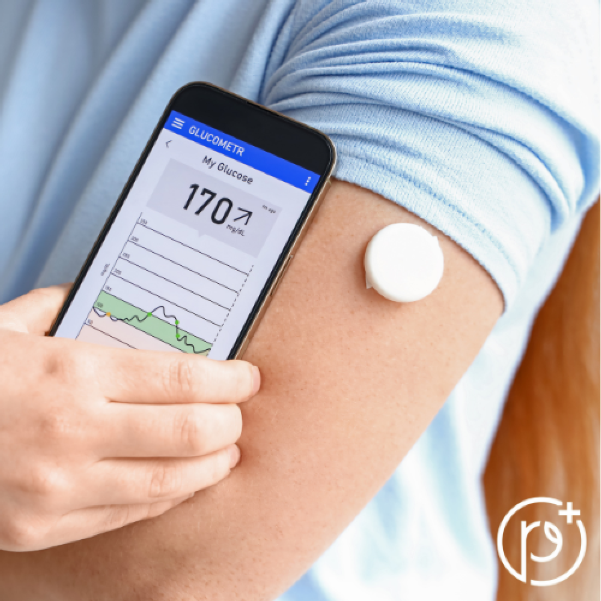I Wore a Continuous Glucose Monitor for a Week So You Don’t Have To
Tuesday, 29 October 2024
This month, continuous glucose monitors (CGMs) became available for type 1 diabetics, fully funded via prescription. These devices are game-changers. Previously, the only way to measure your blood sugar was a single snapshot via a finger prick—and you’d need multiple tests a day to see how your control was. Now, CGMs track your blood glucose over a 14-day period, and some of them only need a smartphone to read the device. Revolutionary and life-changing for these patients—and lately, a wellness trend.
Monitoring blood sugar levels used to be something only people with diabetes did. But recently, glucose has become one of the trendiest things to track for folks aiming to optimise their health. Companies are marketing CGMs to people without diabetes, claiming that knowing your glucose levels can help you lose weight and improve your health. In theory, avoiding glucose spikes could help with weight loss. When carbs are digested, glucose is released into the bloodstream. That prompts the pancreas to secrete insulin, which helps cells take up the glucose and use it for energy. When you don’t use that energy, the extra glucose gets converted to fat, so when more glucose is released during a meal, more of it might get stored as fat. If your body is exposed to high levels of insulin over a long period, it can become less sensitive to insulin—a condition known as insulin resistance. Insulin resistance is a key factor in the development of type 2 diabetes. Manufacturers of CGMs like Abbott and Dexcom are starting to target non-diabetic users, and trendy health experts are extolling their use on various podcasts.
So when Paula Fryer, Dunedin’s friendliest diabetes expert, came into Dunedin’s friendliest pharmacy to train our team on how these CGMs work, I asked if she could attach a device to me. I wanted to see how it felt to wear one and how my body responds to different carbohydrates. My mum is a type 2 diabetic, and family history is a risk factor for developing type 2 diabetes.
Here’s what I learned:
- Harmless to put on and take off: Like most guys, I have an incredibly low pain threshold and am terrified of needles—but I didn’t feel a thing during application and removal. I didn’t even notice it while wearing it; I could roll onto it while asleep and it didn’t bother me.
- Eating after fasting affects your glucose differently: During my “stress testing,” I wanted to consume foods I knew would trigger a massive response. I don’t normally eat breakfast, so when I didn’t eat anything for 16 hours and then ate a hefty serving of white rice and sweet and sour pork, it didn’t create the huge spike I expected.
- High fat and high sugar equals sustained high glucose: Foods loaded with fat and sugar are delicious but keep your blood glucose elevated for longer because fat delays digestion. This means longer exposure to insulin, which can contribute to insulin resistance—a risk factor for type 2 diabetes. Side note: high fat and high sugar foods don’t exist in nature—but are too readily available through drive-throughs across the motu. These are known as ultra-processed foods.
- Fibre matters: Eating fruit caused a very low glucose response, but remove the fibre (like in fruit juice), and you get a high spike.
- Feeling sleepy after meals isn’t just in your head: When your body preps for sleep at night, your blood glucose starts to dip, making you feel drowsy. A similar effect can happen after a high-carb meal, where fluctuations in blood sugar levels may contribute to that post-meal slump.
- Snacking stacks your glucose levels: My worst day of blood sugar control involved a tray of delicious donuts. I kept sneaking into the staff room for a treat. Each time, my blood glucose would rise, and before it returned to baseline, I’d snack again, causing it to climb higher and higher.
So, what will I adjust in my lifestyle after this experiment?
Well, it wasn’t as revolutionary as I expected. Turns out donuts aren’t great for your blood sugar control (insert shocked face emoji), and if you have good blood sugar regulation, there’s always a reaction after eating carbs. But how quickly your levels return to normal depends on whether you eat fibre (which reduces the spike—good) and fat (which slows digestion—bad) with it.
Instead of stressing about which carbs are worse, it hit home that regular snacking on carb-heavy snacks and drinks isn’t great for blood sugar control. Having longer periods without eating—intermittent fasting—is beneficial. So when you’re going to have a feast with friends and family, don’t snack beforehand—then eat like you mean it!
But is wearing a CGM worth it for non-diabetics?
Endocrinologists say CGMs are indispensable for people with diabetes who need to manage their insulin. They can also help guide diet and lifestyle changes for those who have or are at risk of developing type 2 diabetes—that includes adults over 45, those with a family history (like me), or people who are overweight.
For everyone else, it’s a bit murky. Some brands claim that CGMs help with weight loss, but the evidence is thin. Studies show that while glucose levels can vary between people after eating the same food, it’s unclear if knowing these spikes leads to significant health benefits or weight loss. Most young, healthy folks might find that their glucose levels don’t change much, and wearing a CGM becomes more of a novelty than a necessity.
So, should you try one?
I don’t think it’s essential for everyone. It was interesting to see how my body responds to food in real-time, but it didn’t lead to any groundbreaking revelations. However, if you’re curious, have risk factors for diabetes, or want to understand your body’s reactions better, it might be worth giving it a go.
You can purchase these CGMs from our pharmacy, and of course, we’re always here to chat about you and your family’s health anytime!
Andy and the team at the Roslyn Pharmacy






